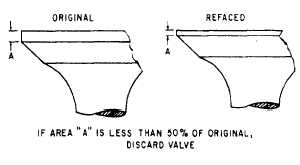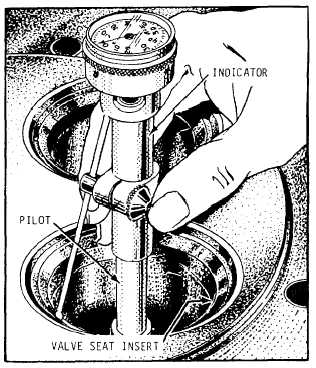in the chuck. If the valve is centered properly, then the valve stem is bent and the valve must be replaced. Remove only the amount of metal necessary to true up t he face and remove the pits. Make sure there is a proper margin of thickness, as shown in figure 3-17. If this margin cannot be retained after refacing, the valve must be discarded.
There are many different makes and models of valve-refacing machines. Make sure that you read and understand the instructions that apply to the machine you are using.
VALVE GUIDE SERVICING
When servicing valve guides, remember that the guides must be clean and in good condition for normal valve seating. If, after cleaning a valve guide, you find it worn, remove it and install a new one. To remove old or worn valve guides and install new ones, you need special guide removing and replacing tools.
One procedure for checking valve guide wear is as follows. Remove the cylinder head from the vehicle to a clean safe working area. Remove the valve springs and clean the valves and valve guides. Insert the valve into the guide, allowing the valve to remain off of its seat. Attach a dial indicator to the cylinder head with the gauge button just touching the edge of the valve head. Watch the dial indicator gauge face, and move the valve head sideways to determine the amount of valve guide wear.
Another checking procedure involves the use of a small hole gauge to measure the inside diameter of the guide and a micrometer to measure the valve stem; the difference in the readings will be the clearance. When the maximum clearance is exceeded, the valve guide needs further servicing before you can proceed. If the valve guide is of the integral type, you must

Figure 3-17. - Proper valve margin of thickness after refacing.
ream it to a larger size and install a valve with an oversized stem. But if the guide is replaceable, you should remove it and install another one.
To remove valve guides, you will need a special puller. On many L-head engines, you can drive the guides down into the valve spring compart- ment and then remove them. You can use an arbor press to remove guides from the overhead type of engines.
To replace the guides, use a valve guide driver or a valve guide replacer except on overhead valve engines, where an arbor press is necessary. In any case, the guides must be installed to the proper depth in either the block or head, as specified by the manufacturer.
After the valve guides are serviced and the valve seats ground, check the concentricity of the two with a dial indicator. (See fig. 3-18.) Any irregularity in the seat will register on the dial.
VALVE SEAT GRINDING
Two general types of valve seat grinders are in use. One is a concentric grinder; the other, an eccentric grinder. Only the concentric grinder is discussed here because of its greater availability.
In the concentric valve seat grinder (fig. 3-19), a grinding stone of the proper shape and angle

Figure 3-18. - Determining concentricity of the valve seat with a dial indicator.
Continue Reading